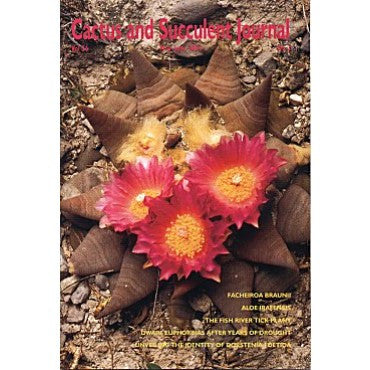CSSA
Journal Vol 76-3
Journal Vol 76-3
Couldn't load pickup availability
May - Jun 2004
Under Discussion: Anacampseros
Fred Dortort
Mammillaria tetrancistra and M. guelzowiana Care, culture and hybridization
Malcom Burleigh
Facheiroa braunii Esteves - A new species of Cactaceae with a review of the genus Facheiroa
Eddie Esteves Pereira
Fifty Thousand Flowers
David Symon
Aloe irafettnsis, A beautiful new distichous species from The Yemen
John Lavranos, Tom McCoy & Abdul Nasser Al-Gifri
Sedums of Europe - Stonecrops and Wallpeppers
Book Review by Ray Stevenson
Dwarf Euphorbias after Years of Drought
Andrew Wilson
More on Clark Champie
Colin Walker
The Malodorous Or The Curly? Unveiling the identity of Dorstenia foetida
Matija Strlic
Superb Succulents
Duke Benadom
The Fish River Tick Plant, A newly described dwarf succulent from the Albany Center of Endemism
Tony Dold & Estelle Brink
Succulents on Stamps: Melocactus
Peg Spaete
On the cover: Ariocarpus retusus is one of the most widely distributed, and the most variable species of the genus. Plants growing in the area of Aramberri, Mexico in the state of Nuevo Leon, have attracted special attention for even greater variability within the individual colonies. The plant illustrated on the cover (photographed by Rob Skillin in the fall of 1995) comes from a colony east of town where vegetative characteristics range from classic retusus (broad, blunt, gray-green tubercles) to forms more suggestive of trigonus (long, sharply pointed, yellow-green, incurving tubercles). Plants may or may not have an areolar pad on the tips or their tubercles. Flower color just adds to the confusion: the retusus-like plants have deep pink flowers, as pictured, not the expected white, while trigonus-like plants have white flowers with none exhibiting the expected yellow. Such mixed characteristics have led to the speculation that these colonies are natural hybrid swarms, which has contributed to the submerging of A. trigonus as a subspecies of A. retusus.


